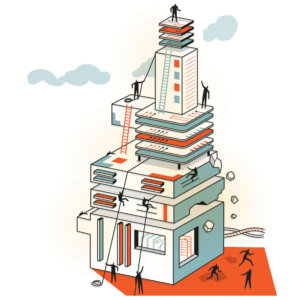Building Digital-Ready Culture in Traditional Organizations
Getting your company into digital shape doesn’t mean dumping everything that has made it strong.
Even though traditional companies find much to admire and learn from in the cultures of born-digital companies, some born-digital qualities are cause for concern. Amazon.com, for instance, launches new businesses quickly and drives repeated efficiency gains in operations. However, it is less admired for what can be seen as uncompromising relationships with publishers, partners, localities, and workers. Uber is revered for its ability to innovate services with agility. But many observers are dismayed by the ways it has seemed to dismiss regulators, exploit drivers, and, in a set of highly publicized incidents, fail to protect workers and customers from harassment.1
Get Updates on Transformative Leadership
Evidence-based resources that can help you lead your team more effectively, delivered to your inbox monthly.
Please enter a valid email address
Thank you for signing up
When Jonas Samuelson became CEO of Stockholm-based home appliance maker Electrolux in 2016, he wanted to reignite innovation and growth by building a faster, more digital-ready organizational culture. Yet many of the practices of Silicon Valley did not seem appropriate for his 100-year-old company or the social and business culture of Scandinavia. Samuelson couldn’t ask 55,000 employees to work 70-hour weeks and couldn’t incentivize them with millions in stock options. He couldn’t fire people just because their core skills started to age. He couldn’t constantly redesign the company’s processes and products — Electrolux makes hardware, not software, and customers expect to keep their products for many years. However, he could drive a culture shift that would energize employees to generate more innovation and profitable growth. He believed strongly that this could change Electrolux for the better without losing what was already terrific about the company.2
Electrolux is not alone in this quest. Many companies are trying to embrace aspects of digital culture without exposing themselves to the less desirable elements of Silicon Valley startups. Consumer electronics and appliances giant Haier has spent years transforming its culture in pursuit of greater speed and innovation while maintaining the efficiency and stability of its traditional manufacturing and logistics processes. KBC Bank is adapting to fight fast-moving fintech entrants while complying with strict European privacy and employee protection regulations. Leaders of Schneider Electric are pushing culture changes to play a major role in the rapidly evolving internet of things while still being a reliable provider of devices upon which thousands of office buildings and data centers depend.
For many legacy companies, culture change is the biggest challenge of digital transformation.
References
1. On internal sexual harassment and subsequent firings, see O. Solon, “Uber Fires More Than 20 Employees After Sexual Harassment Investigation,” The Guardian, June 6, 2017, www.theguardian.com. On CEO Travis Kalanick’s resignation, see M. Balachandran, “A Timeline of Events That Led to the Downfall of Travis Kalanick at Uber,” Quartz India, June 21, 2017, qz.com; on Uber’s policies, see S.A. O’Brien, N. Black, C. Devine, et al., “103 Uber Drivers Accused of Sexual Assault or Abuse,” CNN Business, April 30, 2018, http://money.cnn.com; and S.A. O’Brien, “Uber Will No Longer Force Victims of Sexual Assault Into Arbitration,” CNN Business, May 15, 2018, http://money.cnn.com.
2. Source: author interviews with Electrolux executives. Vignette approved by company.
3. Netflix has adjusted this over the years. For the original deck, see “Freedom & Responsibility Culture (Version 1),” Netflix, 2009, www.slideshare.net; for an updated version of the company’s culture code, see “Netflix Culture,” accessed March 29, 2019, http://jobs.netflix.com.
4. D. Shah, “The HubSpot Culture Code: Creating a Company We Love,” July 15, 2018, http://blog.hubspot.com.
5. In 2015, a New York Times profile of Amazon’s high-pressure work culture drew wide attention as well as pushback from CEO Jeff Bezos and some employees. Since then, the company has explored alternatives to its traditional full-time work schedule, such as shorter workweeks and flextime, and expanded its parental leave options. See, for instance, A. Bhattacharya, “Amazon, Known for Its Soul-Crushing Work Culture, Is Testing a 30-Hour Workweek,” Quartz, Aug. 29, 2016, http://qz.com; and S. Winter, “Two Years In, Our Parental Leave Policy Is Working for Parents,” Aug. 21, 2017, http://blog.aboutamazon.com.
6. S. Wojcicki, “Paid Maternity Leave Is Good for Business,” The Wall Street Journal, Dec. 16, 2014.
7. D. Lyons, “Congratulations! You’ve Been Fired,” The New York Times, April 9, 2016.
8. D. Shah, “How We Fixed a Critical Bug in HubSpot’s Culture Code,” Feb. 15, 2018, www.hubspot.com.
9. Balachandran, “A Timeline of Events.”
10. Laszlo Bock, then Google’s senior vice president of people operations, discussed the company’s approach to performance tracking in L. Bock, Work Rules!: Insights From Inside Google That Will Transform How You Live and Lead (New York: Twelve, 2015).
11. D. Gledhill, “Executing the Digital Strategy” (presentation at the DBS Digital Transformation Investor Day, Singapore, Nov. 17, 2017).
12. Vignette developed from author interviews and external sources and approved by DBS executives.
13. Gledhill, “Executing the Digital Strategy.”
14. Source: author interviews with executives at each company.
15. Since becoming CEO, Satya Nadella has spoken extensively about these two types in discussions of the kind of culture he’s trying to build at Microsoft. He credits Stanford psychologist Carol Dweck for identifying them and for the insight that the “learn-it-all” will do better even if the know-it-all starts with more capability; see C.S. Dweck, Mindset: The New Psychology of Success, updated ed. (New York: Ballantine, 2007).
16. G. Westerman, D. Bonnet, and A. McAfee, Leading Digital: Turning Technology Into Digital Transformation (Boston: Harvard Business Review Press, 2014); and C. Stanway-Williams, “How Lloyds Are Embracing the Digital Age,” April 9, 2018, http://channels.theinnovationenterprise.com.
17. Source: author visit to Luculent headquarters, 2018.
Acknowledgments
This research was conducted through the generous financial support of Microsoft Corp.


Comments (6)
Elizabeth Hamblin
Elizabeth Hamblin
Anne Bartlett-Bragg
Sunga Kim
Elizabeth Hamblin
Sunga Kim